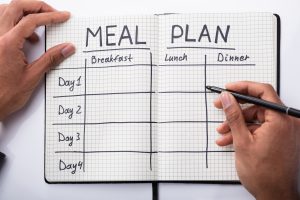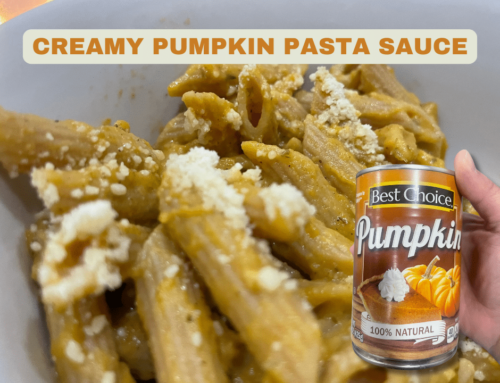Save Time, Money by Planning Your Menus
Wouldn’t it be nice if you only had to think about what you were going to make for dinner once a week? You picked up all your WIC food. Now what are you going to make?
Between changing diapers and making sure your tot doesn’t run headfirst into danger, finding time to get a healthy meal on the table can be a real struggle. You might find yourself opening the fridge at crunch time, searching for anything you can throw together that your family will eat.
We all know eating healthy is important, but dinnertime can creep up on you every single day. We have all been there. Give meal planning a try.
It can sound intimidating, but it can make feeding your family much easier. You don’t have to spend an entire day in the kitchen or even buy up lots of ingredients in advance. It just takes a little planning, and you can save you lots of time and money.
Think of meal planning as a tool to maximize your ingredients in a way that will also help you make the most of your time. It just means you have to think ahead.
MAKE A PLAN, KEEP IT SIMPLE

Use the WIC foods in your kitchen to come up with a meal plan. Our tips will show you how.
Pick a day once a week to write out a menu. Use whatever method you prefer, paper and pen, or even your smartphone. You can make your plan anytime when you have a little extra time (like after the kids go to bed). This process won’t take long, and as you get familiar with the steps you will be planning with ease.
First, survey the ingredients you already have on hand. Search your pantry, refrigerator and freezer.
Use the ingredients you already have to come up with several dinner ideas you think your family would love. Next, look for the ingredients the recipes might have in common. No reason to cook the same thing twice. Cook once even if it means you have to cook more of the ingredient. For example, if you have two recipes with rice, cook enough for both meals. Store the cooked rice in the refrigerator until it is needed for the second recipe. In some cases, it might make more sense to freeze the extra ingredient you cooked.
Leftover roasted vegetables can be eaten as a side one night and served on top of a whole grain rice bowl the next night. Leftover beans can also be used in a rice bowl. Roasted vegetables such as asparagus, broccoli, onions and peppers are also great in an omelet the next day.
If you have extra veggies sitting in your fridge at the end of the week, don’t let them waste. Toss them in a non-stick skillet to create a quick stir-fry.
HEALTH COMES FIRST WITH WIC FOOD
When picking your recipes and ingredients make sure you are selecting healthy options. There are many tools online. One of our favorite sites is the USDA’s choosemyplate.gov.
The website is a great tool to have at your fingertips when searching for tips to make a menu. On the site, you will even find pointers for eating on a budget. There are also some great recipes the entire family will love. Visit choosemyplate.gov/myplatekitchen/recipes to find a few to try this week.
The USDA even has recommendations on how to plan meals. They suggest being mindful of using ingredients you already have, create a recipe list, think about your schedule for the week and plan to use leftovers. Use their printable calendar to help plan your meals.
WIC FOOD, CLASSES
Texas WIC also offers guidance online. They even have online classes and explore topics such as “Cooking with Fruits and Vegetables” and courses for “Feeding Tips for Children 1-2 Years Old” and another course for 2-5 year olds. They also have a course on “Food Safety at Home” that could come in handy.
When searching for healthy recipes, you can also browse a collection provided by Texas WIC.
The program is a helpful resource for expecting mothers and mothers of children up to age 5 years old. The program is 100% free to those that qualify. It’s aimed to help pregnant and breastfeeding mothers get a healthy start for their infants and children up to age five.
WIC also helps you stretch your food budget. WIC recipients can shop for free WIC food such as fresh fruit and vegetables, milk, and even specialty formula. To find out if you qualify, visit a WIC clinic or apply online.
RECIPES USING WIC FOOD
To get you started, here are a few budget-friendly recipes from the USDA’s ChooseMyPlate.gov you are sure to love. These recipes, using WIC food, are perfect to use in your meal planning this week.
The following recipe is credited to: Author, USDA Center for Nutrition Policy and Promotion. Black Bean Burgers. MyPlate Kitchen.
Black Bean Burgers
- Makes: 4 Servings
- Prep Time: 30 minutes
- Cook Time: 30 minutes
Black beans and cooked rice are used as the base of these delicious burgers. Flavored with scallions, garlic and spices, these are sure to please the whole family.
- 1 can 15.5 ounce low-sodium black beans (drained and rinsed with cold water)
- 1 large egg
- 1/2 cup cooked brown rice
- 2 scallions (green and white minced about 1/4 cup)
- 2 tablespoons Chopped fresh cilantro (or basil leaves or a combination)
- 1 clove garlic (peeled and minced)
- 1/4 teaspoon dried oregano or basil
- 1 teaspoon vegetable oil
- 1/2 teaspoon salt
- 1/2 teaspoon black pepper
- 4 whole-wheat buns
Add beans to a bowl and mash with a fork until chunky. Then add the egg and mix well. Add precooked rice, scallions, garlic and oregano, salt and pepper and mix until well combined. Divide the mixture into 4 portions and form each portion into a patty about ¾ to 1 inch thick. Place a large skillet on the stove on high heat. When the skillet is hot, add oil. Add burgers and cook 4 to 5 minutes per side until browned on both sides and heated throughout. Place on a whole wheat bun.
Notes
- Use old-fashioned rolled oats, leftover cooked barley or Panko breadcrumbs instead of prepared rice.
- Serve with your favorite toppings such as lettuce, tomato, guacamole, salsa, low-fat cheese, or low-fat yogurt.
Source: USDA Center for Nutrition Policy and Promotion
The following recipe is credited to: Author, USDA Center for Nutrition Policy and Promotion. Spanish Frittata. MyPlate Kitchen.
Spanish Frittata
- Makes: 4 Servings
- Cook Time: 30 minutes
This versatile recipe combines eggs, potatoes, and onion going from stovetop to oven for the finishing touch. Cut into wedges as part of a delicious breakfast, brunch or any meal.
- 2 russet potatoes (scrubbed)
- 6 eggs
- 2 teaspoons vegetable oil
- 1 medium yellow onion (peeled and chopped)
- 1/2 teaspoon Kosher salt
- 1/4 teaspoon black pepper
Preheat the oven to 400 degrees. Put the potatoes in a non-stick skillet on the stove and cover with cold water. Turn the heat to medium-high and cook about 15 minutes until the potatoes are easily pierced with a knife. Drain the potatoes well and set aside to cool. Then peel and cut into 1-inch cubes. Put the eggs, salt, and pepper in the bowl and mix well with a whisk. Return the skillet on the stove and turn the heat to medium-high. Add the oil. Then add onion and cook about 5 minutes until soft. Add the cubed potatoes. Pour the egg mixture over the potatoes and onions. Press down with a spatula to make an even layer and shake gently to prevent sticking. Lower to medium heat and cook about 7 minutes. Transfer the skillet to the oven and cook until the frittata is completely set, about 5 minutes. Gently loosen frittata from the pan. Place a serving plate over the skillet and carefully invert the frittata onto the plate. Slice into 4 wedges. Serve warm.
Source: USDA Center for Nutrition Policy and Promotion




Leave A Comment